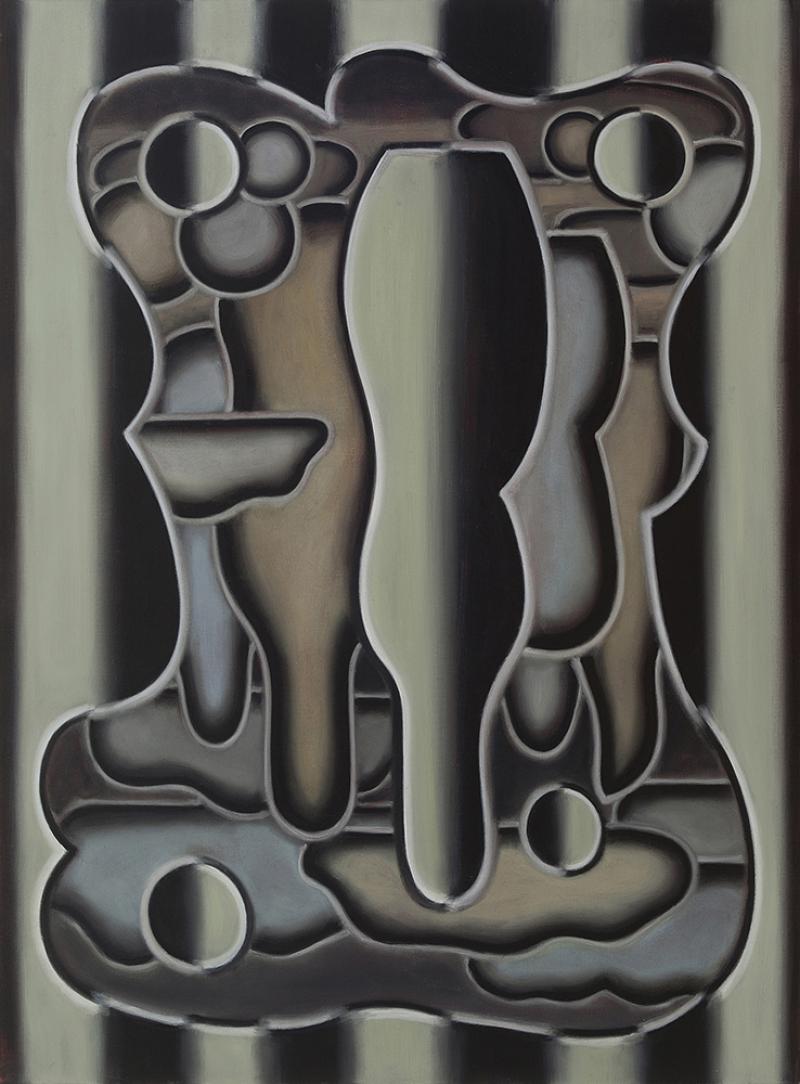PAUL BOSTON born 1952
Torso (torso with upside-down interior) 2001
Estimate: $10000 - 12000
Sold For:
$14000 hammer
Description
PAUL BOSTON born 1952
Torso (torso with upside-down interior) 2001
oil on linen
145.0 x 107.0 cm
Provenance:
Niagara Galleries, Melbourne
Private collection, Melbourne
Exhibited:
Paul Boston New Paintings 2001, Niagara Galleries, Melbourne, 30 October - 24 November 2001, cat.8
Reference:
Paul Boston New Paintings 2001, Niagara Galleries, Melbourne, 2001, cat.8, p.13 (illus)
Estimate: $10000 - 12000
Result Hammer: $14000
In an interview with Dr Ted Gott, Senior Curator of International Art at the National Gallery of Victoria, the highly private Paul Boston uncharacteristically offered up a statement that reveals something of his artistic mindset:
My works are open-ended plays of the mind. They are reflections of the nature of the mind. For myself, I feel a sense of doubt, or ridiculousness, about how we describe our world.1
This intriguing statement points at some of Boston’s uniqueness. It is certainly not that he is uncertain or paralysed into inaction, nor has he retreated from the world as though he sees no alternative. On the contrary, Boston aims, in art and life, for a sense of what the Japanese call “mushin no shin” (the mind without mind) – a flowing state of deeply absorbing self-less engagement with the world of things, experiences and acts without the whispering distractions and interrupting promptings of the ego. The famous D.T. Suzuki has written most eloquently on this phenomenon, but the books by Eugene Herrigel, the former Professor of Philosophy at the University of Erlangen-Nüremberg, entitled Zen in the Art of Archery (1953) and especially R. H. Blyth’s Zen in English Literature and Oriental Classics (1942), which tabulates its universal applications, are most enlightening.
The point is that Boston has listened to the same voice. He spent a total of twelve months in two separate Japanese monasteries near Kyoto (including the Higashi-Zaka) during his four-year period living in Asia and the mental training and its cleansing of Western rusted-on habits of mind stays with him to this day. He still retreats to a particular section of the Grampians, 235 kilometres West of Melbourne, to respond to the landscape in ways that transcend any pictorial traditions or enculturated conventions – for him it is a mindful exercise in stripping away preconceptions of vision. One can look at the landscape and the world of things and respond to it – or, one can look at the beholder and the act of beholding. Boston gravitates to the latter.
One goes to France and sees versions of Monet’s vision; in England ones looks for and sees Constable at every stile. In Australia, one always welcomes the sight of Streetonesque elements and McCubbin’s warm envisioning is never far away. One’s eyes are coloured too by Williams’s marvellous scrubland and Arkley’s world of suburbiana.
There is none of this in Boston – his is a vision not of a particular place or time, rather it is about the reality of the thing being created. This is exactly what drew attention and led to his work being selected for exhibition at New York’s Museum of Modern Art in 1984.
With all this in mind, Boston’s painting Torso (torso with upside-down interior) of 2001 presents as a feat of equanimity and balance. All its varied and asymmetrical compositional elements are in a state of stasis. No element is dominant, no brushwork screams for attention, there is no bravura dash, no “self expression” and no distracting drama. All is concentrated upon spatial and pictorial harmony – from its close and subtle tones and subdued colours to its equipoised balance of fine and broad lines with their clear and fuzzy chalk-like treatments. The entire painting is “honed” into existence through careful deliberation – the result is almost hieroglyphic in its insistence and even-handed visual balance – it exists as a stamp of a state of mind.
… everything happens in process. Only when things happen and results are experienced can things proceed. … I have noticed the futility of exerting my will in the process. Things occur, I work away … (Paul Boston)2.
Footnotes:
1. Paul Boston interviewed by Ted Gott, 19 June 1986, Niagara Galleries Archive (File: Boston).
2. Boston Archives (hand written note, 1996)
Literature:
Catalano, G., The Years of Hope: Australian Art and Criticism 1956-68, Oxford University Press, Melbourne, 1981.
Heathcote, C., “Paul Boston”, North: Art from the Other Side of the Yarra, La Trobe University Art Museum, Bulleen, 2003.
Heathcote, C., “Paul Boston”, Untitled: Portraits of Australian Artists, Macmillan Publishing, Melbourne, 2007.
Smith, B., Smith, T., Heathcote, C., Australian Painting, 1788-2000, Oxford University Press, South Melbourne, 2001.
Associate Professor Ken Wach
Dip. Art; T.T.T.C.; Fellowship RMIT; MA; PhD.
Emeritus Principal Research Fellow and Head of the School of Creative Arts
The University of Melbourne.
Location
SYDNEY VIEWING. 6 - 9 March 11am - 6pm. 12 Todman Avenue, Kensington
MELBOURNE VIEWING. 13 - 19 March 11am - 6pm. Stonington Mansion, 336 Glenferrie Rd, Malvern
